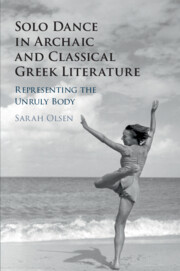Book contents
- Solo Dance in Archaic and Classical Greek Literature
- Solo Dance in Archaic and Classical Greek Literature
- Copyright page
- Dedication
- Contents
- Figures
- Acknowledgments
- Notes on Texts, Abbreviations, and Style
- Introduction
- Chapter 1 The Fantastic Phaeacians
- Chapter 2 Io’s Dance
- Chapter 3 Dance at Work
- Chapter 4 Dance and Dissonance
- Chapter 5 Staging Madwomen
- Chapter 6 Agency, Narrative, and the Dancing Girl
- Chapter 7 Dance History
- Conclusion
- Bibliography
- Index Locorum
- General Index
Chapter 6 - Agency, Narrative, and the Dancing Girl
Published online by Cambridge University Press: 30 November 2020
- Solo Dance in Archaic and Classical Greek Literature
- Solo Dance in Archaic and Classical Greek Literature
- Copyright page
- Dedication
- Contents
- Figures
- Acknowledgments
- Notes on Texts, Abbreviations, and Style
- Introduction
- Chapter 1 The Fantastic Phaeacians
- Chapter 2 Io’s Dance
- Chapter 3 Dance at Work
- Chapter 4 Dance and Dissonance
- Chapter 5 Staging Madwomen
- Chapter 6 Agency, Narrative, and the Dancing Girl
- Chapter 7 Dance History
- Conclusion
- Bibliography
- Index Locorum
- General Index
Summary
Chapter Six focuses on the figure of the orchēstris (sympotic female dancer) in the Greek cultural and literary imagination. Since these women have received little attention as a distinct category of performer, I begin by surveying both visual and textual evidence to build up an understanding of how orchēstrides were eroticized, objectified, and largely silenced by extant Greek sources. I then argue that both Xenophon’s Symposium and Theopompus’ On the Funds Plundered from Delphi use the figure of the orchēstris to address questions about gender, social order, agency, and authority. I show that these two strikingly different texts (philosophical and historical) both hint at the unsettling power of the attractive yet unruly female dancer.
Keywords
- Type
- Chapter
- Information
- Solo Dance in Archaic and Classical Greek LiteratureRepresenting the Unruly Body, pp. 150 - 177Publisher: Cambridge University PressPrint publication year: 2020

